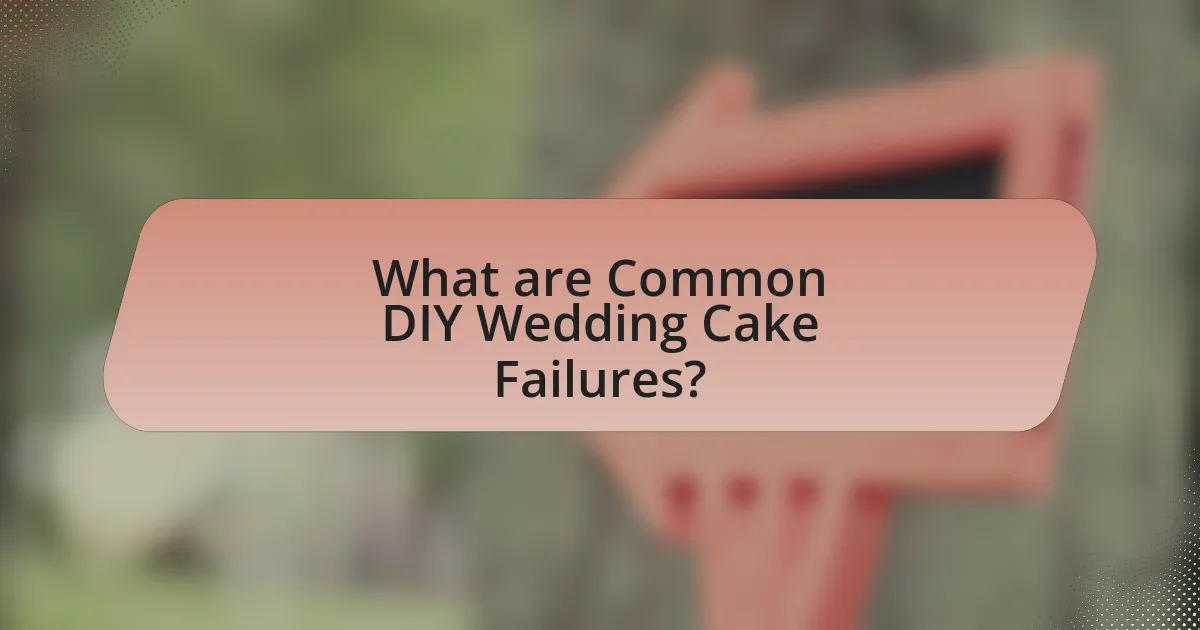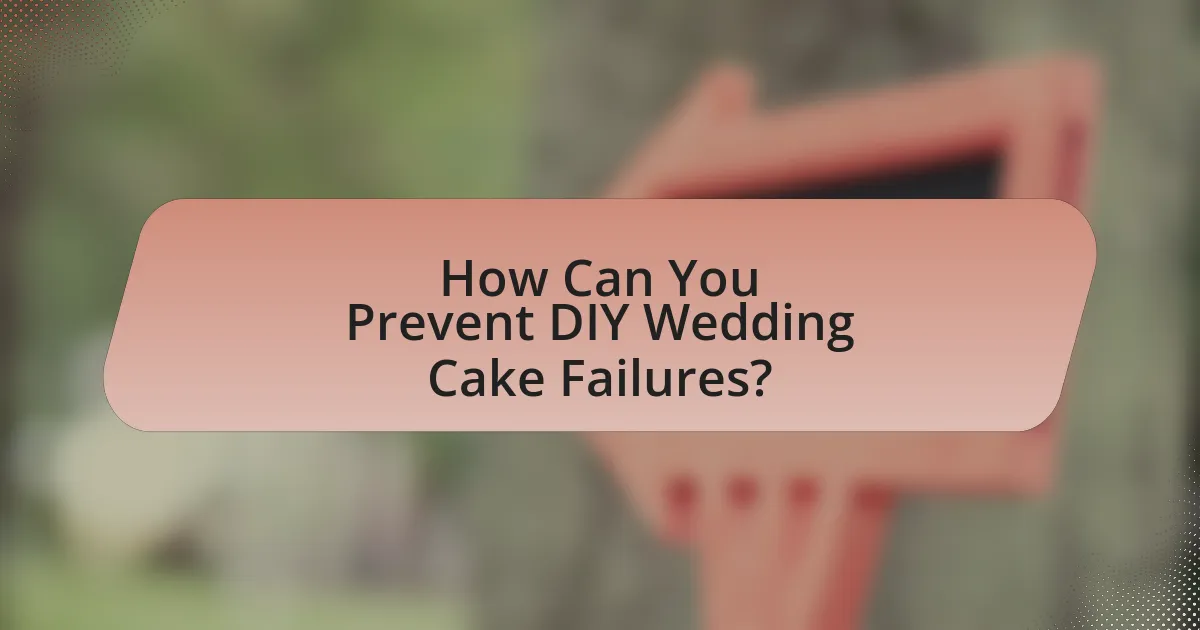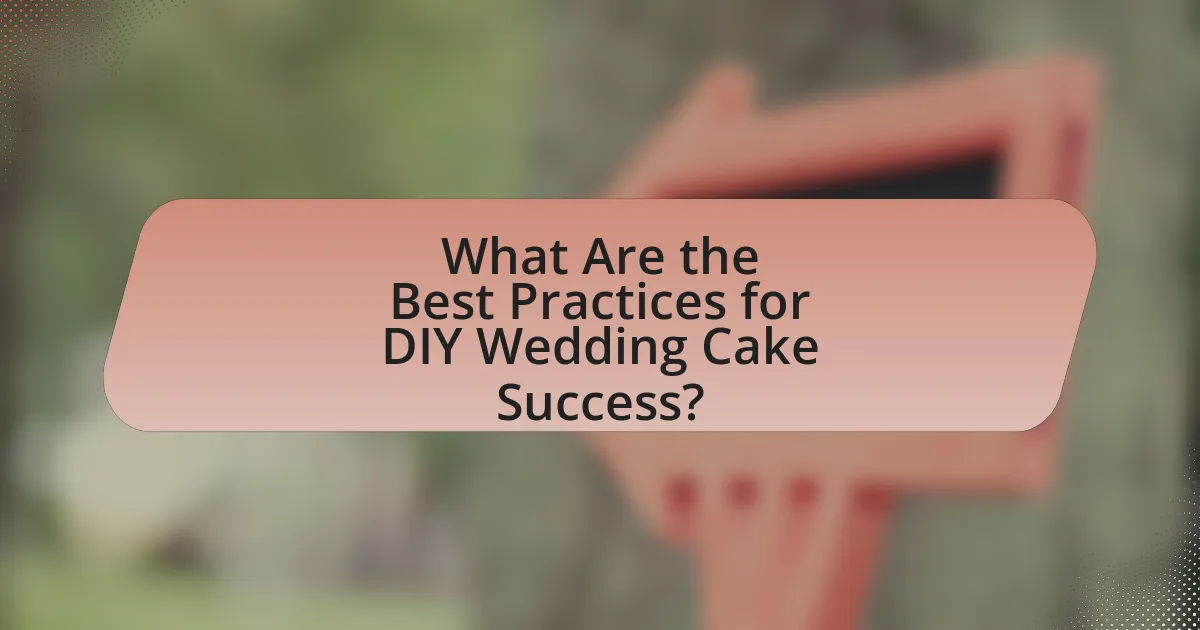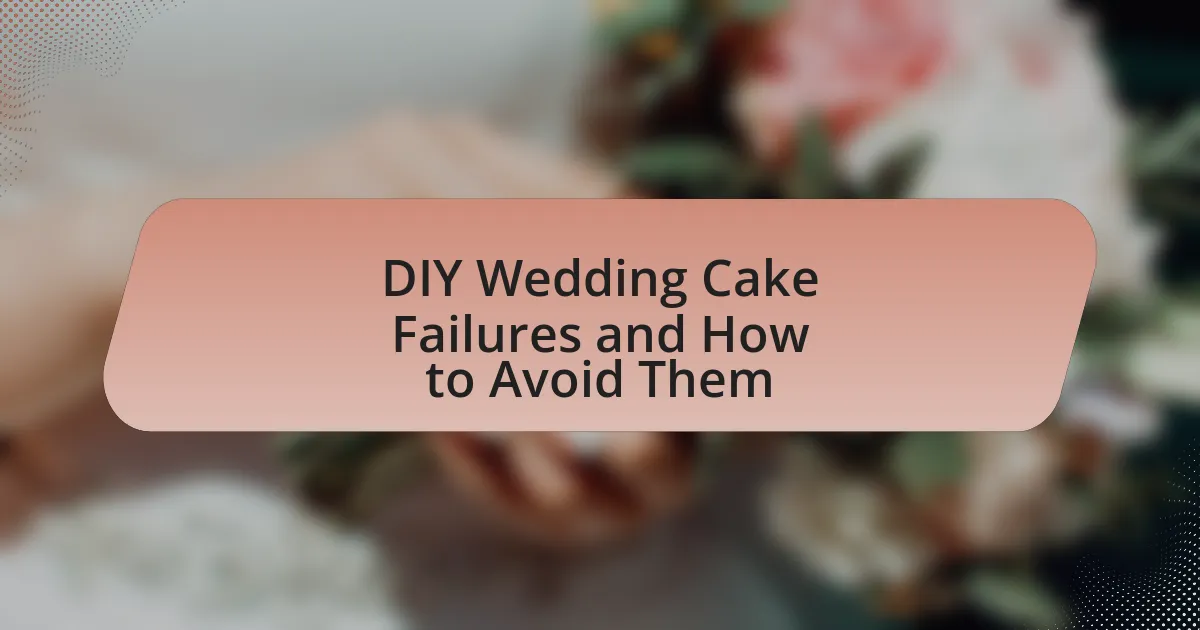DIY wedding cakes often encounter failures such as structural collapse, uneven baking, and poor frosting application, primarily due to a lack of baking experience and inadequate preparation. Common mistakes include improper planning, insufficient baking time, and neglecting structural support, which can lead to undesirable textures and appearances. Ingredient choices significantly impact the cake’s success, influencing texture and flavor, while proper baking techniques and tools are essential for achieving a well-structured cake. This article outlines the frequent pitfalls in DIY wedding cake creation and provides practical tips for prevention, ensuring a successful and visually appealing cake for the special occasion.

What are Common DIY Wedding Cake Failures?
Common DIY wedding cake failures include structural collapse, uneven baking, and poor frosting application. Structural collapse often occurs due to inadequate support or stacking, leading to a cake that cannot hold its own weight. Uneven baking results from inconsistent oven temperatures or incorrect pan sizes, causing some layers to be overcooked while others remain undercooked. Poor frosting application can stem from using the wrong consistency of frosting or not chilling the cake properly before decorating, resulting in a messy appearance. These failures can significantly impact the cake’s presentation and taste, making it essential for DIY bakers to understand and address these issues.
Why do DIY wedding cakes often fail?
DIY wedding cakes often fail due to a lack of baking experience and inadequate preparation. Many individuals underestimate the complexity of cake baking, which requires precise measurements, proper mixing techniques, and an understanding of baking times and temperatures. For instance, a study by the American Institute of Baking highlights that 30% of home bakers struggle with achieving the right cake texture, leading to dense or dry outcomes. Additionally, insufficient knowledge about cake decoration can result in structural failures, such as collapsing layers or melting frosting, especially under warm conditions.
What are the most frequent mistakes made in DIY wedding cakes?
The most frequent mistakes made in DIY wedding cakes include improper planning, inadequate baking time, and insufficient structural support. Many individuals fail to create a detailed timeline for baking and decorating, leading to rushed efforts that compromise quality. Additionally, underbaking or overbaking cakes can result in undesirable textures, affecting the overall taste and appearance. Furthermore, neglecting to use dowels or other supports for multi-tiered cakes often leads to structural collapse, which is a common issue in DIY projects. These mistakes are frequently documented in baking guides and forums, emphasizing the importance of preparation and technique in successful cake creation.
How do ingredient choices impact the success of a DIY wedding cake?
Ingredient choices significantly impact the success of a DIY wedding cake by influencing texture, flavor, and structural integrity. For instance, using high-quality flour can enhance the cake’s texture, while fresh eggs contribute to moisture and richness. Additionally, the choice of leavening agents, such as baking powder or baking soda, directly affects the cake’s rise and overall density. Research indicates that cakes made with the appropriate ratios of ingredients, such as fat to flour, yield better results; for example, a study published in the Journal of Culinary Science & Technology found that cakes with a balanced fat-to-flour ratio produced superior volume and crumb structure. Therefore, careful selection of ingredients is crucial for achieving a successful DIY wedding cake.
What are the signs of a failed DIY wedding cake?
Signs of a failed DIY wedding cake include a sunken top, which indicates underbaking or improper mixing, and a dry texture, suggesting overbaking or insufficient moisture. Additionally, a cracked surface often points to rapid temperature changes during baking, while a dense or gummy consistency can result from incorrect ingredient ratios or inadequate mixing. Lastly, an off-putting smell or taste signifies spoilage or the use of expired ingredients. These indicators are critical for assessing the quality of a wedding cake and ensuring it meets the celebratory standards expected at such an event.
How can you identify structural issues in a DIY wedding cake?
To identify structural issues in a DIY wedding cake, examine the cake layers for stability and alignment. A cake that leans or has uneven layers indicates potential structural problems. Additionally, check for proper support; using dowels or cake boards is essential to prevent sagging. If the cake feels excessively heavy or the frosting is cracking, these are signs of inadequate support or moisture imbalance. Properly assessing these factors can help ensure the cake maintains its intended shape and integrity throughout the event.
What are the visual indicators of a poorly made wedding cake?
Visual indicators of a poorly made wedding cake include uneven layers, which can suggest improper baking or stacking techniques. Additionally, a cake with noticeable cracks or bulges indicates structural instability, often due to inadequate support or overbaking. Poorly applied frosting, such as uneven or excessive amounts, can also detract from the cake’s appearance, signaling a lack of skill in decoration. Lastly, a cake that shows signs of sinking or collapsing is a clear visual cue of inadequate preparation or ingredient ratios. These indicators collectively reflect the quality and craftsmanship of the wedding cake.

How Can You Prevent DIY Wedding Cake Failures?
To prevent DIY wedding cake failures, ensure precise measurements and follow a reliable recipe. Accurate ingredient ratios are crucial, as even slight deviations can lead to structural issues or undesirable textures. For instance, using a kitchen scale for measuring flour and sugar can enhance consistency, as studies show that weight-based measurements yield better baking results. Additionally, allow ingredients to reach room temperature before mixing, as this promotes even blending and optimal rise. Lastly, conduct a test bake to identify any potential issues with the recipe or oven settings, which can help in making necessary adjustments before the actual event.
What essential tips should you follow when baking a DIY wedding cake?
To successfully bake a DIY wedding cake, ensure you follow these essential tips: first, use high-quality ingredients, as they significantly impact the cake’s flavor and texture. For example, using fresh eggs and real butter can enhance the cake’s richness. Second, accurately measure all ingredients to maintain the correct balance, which is crucial for achieving the desired rise and consistency. Third, allow your cake layers to cool completely before frosting to prevent melting and sliding. Additionally, consider baking your cake in advance and freezing it, as this can improve moisture retention. Lastly, practice your decorating skills beforehand to ensure a polished final presentation. These tips are supported by baking experts who emphasize the importance of ingredient quality and proper technique in achieving a successful wedding cake.
How important is recipe selection for a successful DIY wedding cake?
Recipe selection is crucial for a successful DIY wedding cake. The right recipe ensures the cake has the desired texture, flavor, and structural integrity necessary for a wedding event. For instance, a recipe that balances ingredients properly can prevent common issues such as collapsing or uneven baking, which are often cited as reasons for DIY wedding cake failures. According to a study published in the Journal of Culinary Science & Technology, cakes made from well-tested recipes have a significantly lower failure rate compared to those created from unverified or improvised recipes. Therefore, careful recipe selection directly impacts the overall success of a DIY wedding cake.
What role does proper baking technique play in cake success?
Proper baking technique is crucial for cake success as it directly influences the texture, flavor, and overall appearance of the cake. Techniques such as accurate measuring of ingredients, proper mixing methods, and correct baking temperatures ensure that the cake rises evenly and achieves the desired moistness. For instance, using the creaming method correctly incorporates air into the batter, which is essential for a light and fluffy cake. Additionally, maintaining the right oven temperature prevents undercooking or overcooking, both of which can lead to undesirable results. Studies show that cakes baked at the correct temperature and for the appropriate duration yield a more consistent and appealing product, highlighting the importance of mastering baking techniques for successful cake outcomes.
What tools and equipment are necessary for a successful DIY wedding cake?
To successfully create a DIY wedding cake, essential tools and equipment include mixing bowls, measuring cups, a stand mixer or hand mixer, baking pans, a cooling rack, a cake leveler, offset spatulas, and a cake decorating kit. Mixing bowls are necessary for combining ingredients, while measuring cups ensure accurate ingredient quantities. A stand mixer or hand mixer facilitates thorough mixing of batter, and baking pans are required for shaping the cake. A cooling rack allows for proper cooling, preventing sogginess. A cake leveler ensures even layers, and offset spatulas are used for smooth frosting application. A cake decorating kit provides various tools for intricate designs. These tools are fundamental for achieving a well-structured and visually appealing wedding cake.
How can the right baking tools prevent common failures?
The right baking tools can prevent common failures by ensuring precision and consistency in the baking process. For instance, using a digital scale allows for accurate measurement of ingredients, which is crucial for achieving the correct texture and flavor in cakes. Additionally, high-quality bakeware, such as non-stick pans, helps prevent sticking and ensures even baking, reducing the risk of cakes collapsing or burning. Research indicates that using the appropriate tools can significantly enhance baking outcomes, as evidenced by a study published in the Journal of Culinary Science & Technology, which found that proper equipment usage correlates with higher success rates in baking projects.
What equipment is essential for decorating a DIY wedding cake?
Essential equipment for decorating a DIY wedding cake includes a turntable, offset spatula, piping bags, various piping tips, and fondant tools. A turntable allows for easy access to all sides of the cake while decorating, ensuring even application of frosting. An offset spatula is crucial for spreading frosting smoothly and creating clean edges. Piping bags and tips enable intricate designs and decorations, allowing for creativity in the cake’s appearance. Fondant tools, such as rolling pins and cutters, are necessary for working with fondant, which is often used for a polished finish. These tools collectively enhance the decorating process and contribute to a professional-looking cake.

What Are the Best Practices for DIY Wedding Cake Success?
The best practices for DIY wedding cake success include thorough planning, precise measurements, and proper baking techniques. First, create a detailed timeline that outlines each step of the cake-making process, from baking to decorating, ensuring ample time for each phase. Accurate measurements are crucial; using a kitchen scale can help achieve consistency in ingredients, which is vital for the cake’s texture and flavor. Additionally, follow reliable recipes and conduct test bakes to troubleshoot any issues before the wedding day.
Proper baking techniques, such as preheating the oven and using the correct pan sizes, contribute to even baking and prevent common failures like sinking or uneven layers. Finally, allow the cake to cool completely before frosting to avoid melting and sliding. These practices are supported by baking science, which emphasizes the importance of ingredient ratios and temperature control in achieving a successful cake.
How can you ensure your DIY wedding cake is structurally sound?
To ensure your DIY wedding cake is structurally sound, use proper support systems such as dowels or cake boards between layers. Dowels provide essential stability by distributing the weight of the upper tiers, preventing them from collapsing onto the lower ones. For instance, using at least one dowel per tier, cut to the height of the cake, can significantly enhance structural integrity. Additionally, placing a sturdy cake board under each tier helps to evenly distribute weight and provides a solid base. This method is supported by baking experts who emphasize the importance of structural support in multi-tiered cakes to avoid common failures like sagging or collapsing.
What techniques can reinforce the stability of a multi-tiered cake?
To reinforce the stability of a multi-tiered cake, use dowels or straws as structural supports between the tiers. These supports distribute the weight of the upper layers evenly and prevent the cake from collapsing. Additionally, applying a sturdy buttercream or ganache layer between the tiers can help secure them together, providing extra stability. Research indicates that using a central support rod can further enhance stability, especially for larger cakes, by providing a solid core that holds the tiers in place.
How does proper cooling affect the integrity of a wedding cake?
Proper cooling is essential for maintaining the structural integrity of a wedding cake. When a cake cools correctly, it prevents the layers from becoming overly moist or dry, which can lead to collapsing or cracking. For instance, cooling a cake at room temperature allows the steam to escape gradually, ensuring that the cake retains its shape and texture. Additionally, cakes that are not cooled properly may experience uneven settling, which compromises their overall appearance and stability. Therefore, following proper cooling techniques directly influences the cake’s ability to withstand decoration and transportation, ultimately preserving its intended design and quality.
What are some decoration tips to enhance the appearance of your DIY wedding cake?
To enhance the appearance of your DIY wedding cake, consider using fresh flowers, edible glitter, and intricate piping techniques. Fresh flowers add a natural and elegant touch, while edible glitter can create a shimmering effect that catches the eye. Intricate piping techniques, such as lace or floral designs, can elevate the cake’s visual appeal and showcase your baking skills. According to a survey by The Knot, 70% of couples prioritize cake aesthetics, indicating that visually appealing cakes are highly valued in wedding planning.
How can you choose the right frosting to avoid melting or sliding?
To choose the right frosting that avoids melting or sliding, opt for buttercream or ganache, as these frostings maintain their structure better in varying temperatures. Buttercream, particularly when made with high-fat content, provides stability and can withstand heat better than lighter frostings like whipped cream. Ganache, made from chocolate and cream, also solidifies when cooled, making it less prone to melting. According to a study by the American Institute of Baking, frostings with higher fat content have a lower melting point, which supports the choice of buttercream or ganache for stability.
What are some creative decoration ideas that are easy to execute?
Some creative decoration ideas that are easy to execute include using fresh flowers, which can enhance the aesthetic of a wedding cake without requiring advanced skills. Fresh flowers can be arranged simply by placing them strategically on the cake, adding color and elegance. Another idea is to utilize edible glitter or sprinkles, which can be easily applied to create a festive look. Additionally, incorporating fruit, such as berries or citrus slices, can provide a natural and vibrant decoration that complements the cake’s flavor. These methods are not only visually appealing but also practical, as they require minimal tools and can be completed quickly, making them ideal for DIY wedding cakes.
What troubleshooting tips can help salvage a DIY wedding cake?
To salvage a DIY wedding cake, first assess the specific issue, such as structural collapse, dryness, or frosting problems. For a collapsed cake, reinforce it with dowels or cake boards to provide support. If the cake is dry, brush it with a simple syrup made of equal parts sugar and water to add moisture. For frosting issues, if the frosting is too runny, add powdered sugar to thicken it; if it’s too stiff, incorporate a small amount of milk or cream to achieve the desired consistency. These methods are effective because they directly address common cake problems and can restore the cake’s appearance and taste, ensuring it remains presentable for the wedding.
